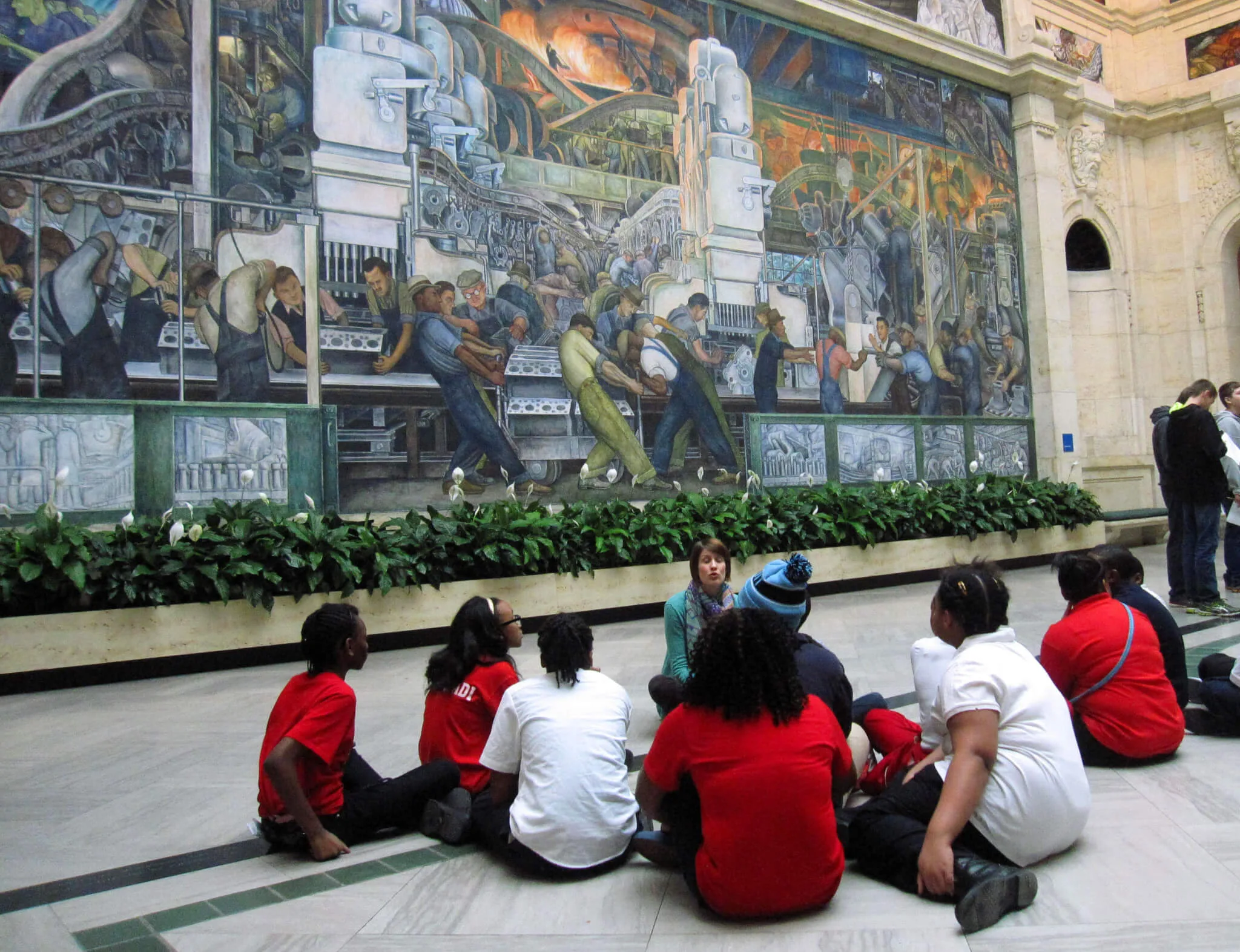
This Dec. 5, 2014 photo shows a class learning about the Detroit Industry Murals at the Detroit Institute of Arts. The murals were done in the 1930s by Diego Rivera as a tribute to Detroits manufacturing industry, and Rivera spent time studying the River Rouge Ford car factory. The museums collection was at one point threatened with a sale to help fund Detroits pension obligations, but finalization of the citys bankruptcy last week included a deal that protects the art. (AP Photo/Beth J. Harpaz)
When did you first learn about Vincent Van Gogh?
Was it in high school art class? While looking through posters to buy for your bedroom? Maybe your parents had a coffee table book with his self portrait on the cover, or you heard “Vincent” by Don McLean on the radio?
However you met the Dutch Post-Impressionist painter—who, after his death, became one of the most famous and influential people in art history—you can probably thank the Detroit Institute of Arts for the introduction.
In 1922, the Detroit Institute of Arts (DIA) became the first American public museum to purchase a Van Gogh painting—his now-iconic Self Portrait with Straw Hat from the summer of 1887. The museum bought the painting for $4,200, the equivalent of $75,000 now.

VISIT: Find Self Portrait with Straw Hat in the Modern section of the DIA, on the second floor near the Diego Rivera murals.
That purchase led to interest from private collectors, shows across the country, and the dawning realization in America that Vincent Van Gogh’s work needed our attention. Today, the DIA’s belief in the then-unknown artist continues to pay dividends for the museum and its visitors.
In 2022—100 years after buying Self Portrait—the DIA presented Van Gogh in America, a 74-piece exhibition telling the story of how Americans fell in love with Vincent Van Gogh. It wasn’t a traveling show, moving from museum to museum on a tour through the country. Van Gogh in America was curated by the museum’s own Jill Shaw.
The Van Gogh exhibition wrapped at the end of January 2023, and not long after, USA Today readers voted the DIA the very best art museum in the United States.
“I think we got a big bounce after the Van Gogh exhibit, which brought people into the museum—locals and international attendants—to see this gem for the first time,” said Tudi Harwood, who’s volunteered at the DIA for 11 years.
Working the information desk on the museum’s northeast side, Harwood said she’s spoken with visitors who say they preferred DIA’s Van Gogh exhibit even to the Van Gogh Museum in Amsterdam.
Westland resident Felicia Jones said she travels abroad often, and has been to a number of major art museums.
“I can see why this one was voted number one,” she said.
For Shanti, a recent Wayne State grad who declined to give her last name, the DIA offered a sense of belonging long before the Van Gogh exhibit began.
“It was kind of like my comfort place while I was at Wayne State,” she said. “I’d never been with my girlfriends before, so I thought it would be a fun trip. I like that there’s constantly new pieces of work here.”
With two friends, Shanti—who said she hasn’t been to many other art museums—was on her way to see the DIA’s self portrait of artist Andy Warhol. But first, she led her group through the African American gallery.
“I like the different variations of art,” she said of the gallery. “I think it shows different sides of being Black—not just putting the experience of being Black under one theme. The art expresses different points of view from different people that are all African Americans. I think it gives us a different voice.”
She’s hoping to visit the Andy Warhol Museum in Pittsburgh next.
That’s part of the magic at the DIA, according to Harwood—it’s welcoming and approachable for everyone, but always has something special, even for the most frequent visitors. For example, she said, the second floor’s centerpiece—a massive 27-panel Diego Rivera Detroit Industry Mural Exhibit gifted to the DIA in 1933 by Edsel B. Ford, the son of Henry Ford—has been around a long time, but continues to reward regular viewers with surprises.
“You have to look really hard, but there is a completed car—it’s about that big,” she said, pinching her fingers in the air.

On any given day, the DIA is filled with wanderers and studiers, with school groups and travelers passing through—all there to visit the now-best art museum in the country. But for the people who live in the area, the DIA is something of a home base. Free to residents of Macomb, Oakland, and Wayne counties—the three most populated counties in the state and home to the poorest city in America—families can check out complimentary strollers, nursing mothers may breastfeed anywhere in the museum or use a special private pod, and school groups and seniors are provided free bus transportation.
As the Detroit Institute of Arts gains increasingly more acclaim from those on the outside, those who grew up with a world just a little richer for what it’s provided—like Vincent Van Gogh and Andy Warhol, or a welcoming cultural touchstone that’s close to home and free to visit—know that it’s always been special.
“It’s designed as a public institution to educate Detroiters and lift them,” Harwood said. “And that’s what it still does today.”

VIDEO: Trump isn’t the only republican facing charges for alleged financial crimes
https://www.tiktok.com/@gandernewsroom/video/7361494909938978090 A whole lot of Michigan Republicans and lobbyists are facing criminal charges for...

VIDEO: It’s expensive to be poor in Michigan
https://www.tiktok.com/@gandernewsroom/video/7361154790300060974 Ever heard of predatory payday loans? Here’s how new laws could help protect...

Here’s everything you need to know about this month’s Mercury retrograde
Does everything in your life feel a little more chaotic than usual? Or do you feel like misunderstandings are cropping up more frequently than they...

The ’Gander wins multiple 2023 Michigan Press Association awards
MICHIGAN—The ’Gander Newsroom has earned multiple awards in the 2023 Michigan Press Association Better Newspaper Contest. The awards were announced...

Michigan Republicans ask Supreme Court to restrict medication abortion access
A lawsuit supported by Republicans could disrupt access to the most common form of abortion—even in Michigan, where reproductive rights are...




